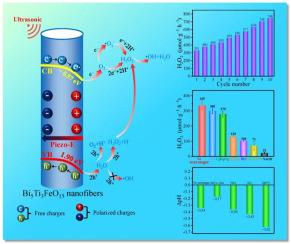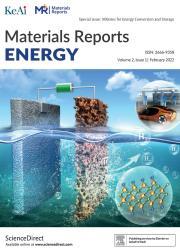Dual-pathway self-promoting piezocatalytic H2O2 generation over Bi5Ti3FeO15 nanofibers and the mechanism
IF 13.8
引用次数: 0
Abstract
Piezocatalytic hydrogen peroxide (H2O2) generation is a promising synthesis method that has received increasing attention; however, the reaction pathway requires further investigation. Here, Bi5Ti3FeO15 nanofibers are used to generate H2O2 by harvesting mechanical energy, and the reaction pathways are investigated. The H2O2 yield over Bi5Ti3FeO15 nanofibers steadily increases from 331 μmol g−1 h−1 in the first cycle to 746 μmol g−1 h−1 in the tenth cycle in pure water without a sacrificial agent. Reliable reaction pathways are revealed by monitoring the pH value changes in the reaction solution during the H2O2 generation process. In the H2O2 generation process, the water oxidation reaction (WOR) provides a large amount of H+ in the reaction solution, which promotes the oxygen reduction reaction (ORR) for H2O2 generation. Therefore, an efficient synergistic effect between ORR and WOR achieves dual-pathway H2O2 generation, contributing to the excellent piezocatalytic performance of Bi5Ti3FeO15 nanofibers. Furthermore, mechanistic studies indicate that the piezocatalytic H2O2 generation follows the energy band theory. This work not only demonstrates Bi5Ti3FeO15 nanofibers as efficient piezocatalysts for H2O2 generation but also provides a simple and effective approach to elucidate reaction pathways. This approach can be applied in photocatalytic, tribocatalytic, and electrocatalytic H2O2 generation.

Bi5Ti3FeO15纳米纤维双途径自促进压电催化生成H2O2及其机理
压电催化生成过氧化氢(H2O2)是一种很有前途的合成方法,受到越来越多的关注;然而,反应途径还有待进一步研究。本研究利用Bi5Ti3FeO15纳米纤维通过收集机械能产生H2O2,并对反应途径进行了研究。在无牺牲剂的情况下,Bi5Ti3FeO15纳米纤维的H2O2产率从第一次循环的331 μmol g−1 h−1稳步提高到第10次循环的746 μmol g−1 h−1。通过对H2O2生成过程中反应溶液pH值变化的监测,揭示了可靠的反应途径。在H2O2生成过程中,水氧化反应(water oxidation reaction, WOR)在反应溶液中提供了大量的H+,促进了生成H2O2的氧还原反应(oxygen reduction reaction, ORR)。因此,ORR和WOR之间的高效协同作用实现了双途径生成H2O2,从而使Bi5Ti3FeO15纳米纤维具有优异的压催化性能。此外,机理研究表明,压电催化生成H2O2遵循能带理论。这项工作不仅证明了Bi5Ti3FeO15纳米纤维是H2O2生成的高效压电催化剂,而且还提供了一种简单有效的方法来阐明反应途径。该方法可用于光催化、摩擦催化和电催化生成H2O2。
本文章由计算机程序翻译,如有差异,请以英文原文为准。
求助全文
约1分钟内获得全文
求助全文
来源期刊

材料导报:能源(英文)
Renewable Energy, Sustainability and the Environment, Nanotechnology
CiteScore
13.00
自引率
0.00%
发文量
0
审稿时长
50 days
 求助内容:
求助内容: 应助结果提醒方式:
应助结果提醒方式:


